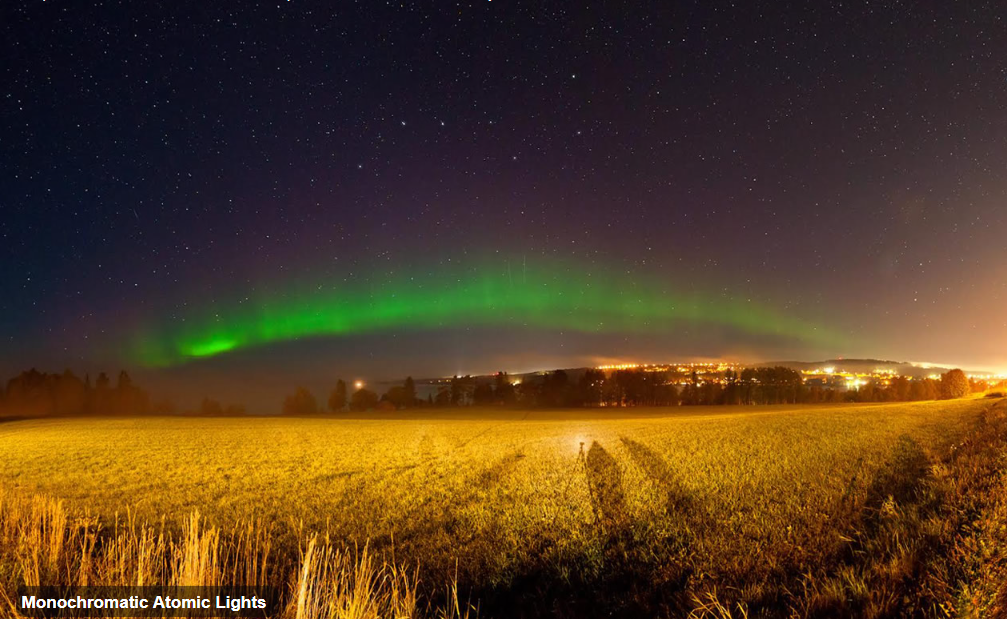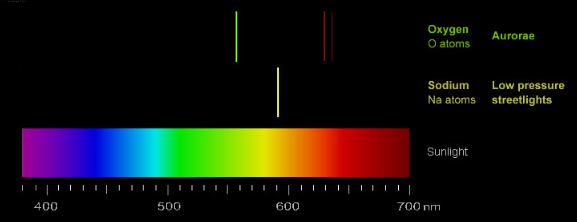Aurorae and monochromatic light - OPOD
Aurorae and Monochromatic Light: Exploring the Phenomenon
Aurorae, also known as the Northern and Southern Lights, are captivating displays of light that grace the night skies near the Earth's poles. These natural phenomena have fascinated scientists and skywatchers for centuries. In this article, we will delve into the intriguing connection between aurorae and monochromatic light, shedding light on the underlying physics and mechanisms behind their mesmerizing glow.
When it comes to monochromatic light, we typically think of light that consists of a single wavelength or color. However, in reality, achieving perfect monochromaticity is challenging due to various factors. The Heisenberg Uncertainty Principle, a fundamental concept in quantum mechanics, plays a role in limiting the monochromatic nature of emitted light. The principle states that the more accurately we try to predict the time of light emission, the greater the uncertainty in its frequency or wavelength.
In the case of aurorae, the emitted light is primarily produced by oxygen atoms in the upper atmosphere that have been disturbed by particles from Earth's magnetotail. These atoms are excited to higher energy states and subsequently relax back to lower energy states by emitting light. Due to the electron spins of each condition being incompatible, ordinary transitions back to the original low energy state are not permitted. However, quantum mechanics allows for alternative pathways, and eventually, the excess energy seeps away, resulting in the familiar green glow of aurorae.
The key difference between street lamps and aurorae lies in their degree of monochromaticity. Street lamps, such as high-pressure sodium lamps, have a higher pressure compared to the upper atmosphere. This pressure broadening effect leads to a spread in the emitted wavelengths, causing their light to be less monochromatic. Astronomers often lament the use of high-pressure sodium lamps as their broadened light pollutes the night sky and cannot be easily filtered.
On the other hand, the light emitted by oxygen atoms in aurorae has an extremely narrow wavelength spread. The uncertainty in the timing of emission, combined with the Heisenberg Uncertainty Principle's pairing with the radiation bandwidth, results in the green light of aurorae having a remarkably precise wavelength. This narrow spread contributes to the vibrant and distinct colors observed in auroral displays.
It is worth noting that sunlight, despite being composed of a wide range of wavelengths, also exhibits pressure broadening due to energetic collisions on its journey from the Sun's core to its surface. However, these broadened wavelengths follow a near thermal equilibrium distribution, leading to a relatively smooth spectrum.
In addition to the fascinating interplay between monochromatic light and aurorae, there are other optical phenomena that can occur simultaneously. For example, the glow around the camera in photographs of aurorae might be attributed to a heiligenschein, a phenomenon caused by dew-wetted stalks and stubble reflecting light back towards the observer. However, it is essential to consider that this glow could also be an opposition effect, which occurs when sunlight is directly reflected back from small particles, creating a bright spot around the observer's shadow.
In conclusion, the study of aurorae and monochromatic light provides a captivating glimpse into the intricacies of quantum mechanics and atmospheric physics. Understanding the underlying mechanisms behind the production of monochromatic light in aurorae enhances our appreciation for these awe-inspiring natural displays. By exploring the degree of monochromaticity in different light sources, such as street lamps and the Sun, we gain insights into the broader spectrum of light phenomena that grace our skies. So next time you catch a glimpse of the mesmerizing colors dancing across the night sky, take a moment to ponder the intricate interplay between monochromatic light and the atmospheric conditions that create these celestial wonders.

Peter Rosen imaged this at Östersund, Sweden. “We had a beautiful little aurora. There was plenty of fog so we had to find a spot higher up and away from the lake to get an almost free view. Behind us there were sodium streetlights with their typical amber color. The streetlights are the lightsource of the heiligenschein around my camera on the tripod.” Nearly all the light in the scene, except that from the stars, is narrow band atomic radiation. ©Peter Rosen, shown with permission
The bound electron waves surrounding atoms can have only discrete energies. When an isolated atom is disturbed in some way, for example by a collision with a high energy particle, an electron wave can have its energy increased to another higher energy discrete state. To be pedantic, the higher energy state need not always be discrete for if the energy is high enough we have a free electron and an ionised atom.
But back to bound electrons. The higher energy electron wave can relax back to a lower energy state by emitting light. The light is, in principle, monochromatic because only discrete electron wave energies exist. In reality, the emitted light is never completely monochromatic. One reason is fundamental, the Heisenberg Uncertainty Principle. The higher the probability of light emission (i.e. the greater the ability to predict the time of its emission) the greater is the light’s frequency spread. Another reason is prosaic. If the atoms are in a high pressure gas, frequent collisions perturb the electron energies and ‘pressure broadening’ spreads the emitted wavelengths.
The degree of monochromaticity is a key difference between street lamps and aurorae.
Street lamp tubes have reasonable pressures compared to the upper atmosphere and therefore have slightly radiation broadened light. Astronomer loathed high pressure sodium street lamps have such extensive pressure broadening that their sky polluting light cannot be filtered.
Auroral discharges are from (in Peter’s case) oxygen atoms in the near vacuum of the upper atmosphere disturbed by particles ejected from Earth’s magnetotail. Quantum mechanics rears its head in that the oxygen high energy state is awkward. Ordinary transitions back to the original low lower energy wave are not permitted because the electron spins of each condition are not compatible. But nearly all things happen in quantum mechanics. The electron energy eventually seeps away in the familiar auroral green glow. But ‘eventually’ is comparable to the age of the Universe in atomic terms. The Uncertainty Principle acts again. The time of the emission is grossly uncertain and its HUP pairing with the radiation bandwidth means that the green light has an extremely narrow wavelength spread.

Sunlight has a near continuous spectrum. The original gamma radiation from the core is downgraded by endless energetic collisions on its long journey to the surface. The resulting pressure broadening produces a near thermal equilibrium 'black body' wavelength distribution. Only absorptions by atoms close to the solar surface mar this smooth spectrum.
Heiligenschein
We cannot be sure whether the glow around the camera is a heiligenschein from dew wetted stalks and stubble. It probably is - but it might be an opposition effect!

Note: this article has been automatically converted from the old site and may not appear as intended. You can find the original article here.
Reference Atmospheric Optics
If you use any of the definitions, information, or data presented on Atmospheric Optics, please copy the link or reference below to properly credit us as the reference source. Thank you!
-
<a href="https://atoptics.co.uk/blog/aurorae-and-monochromatic-light-opod/">Aurorae and monochromatic light - OPOD</a>
-
"Aurorae and monochromatic light - OPOD". Atmospheric Optics. Accessed on April 20, 2024. https://atoptics.co.uk/blog/aurorae-and-monochromatic-light-opod/.
-
"Aurorae and monochromatic light - OPOD". Atmospheric Optics, https://atoptics.co.uk/blog/aurorae-and-monochromatic-light-opod/. Accessed 20 April, 2024
-
Aurorae and monochromatic light - OPOD. Atmospheric Optics. Retrieved from https://atoptics.co.uk/blog/aurorae-and-monochromatic-light-opod/.